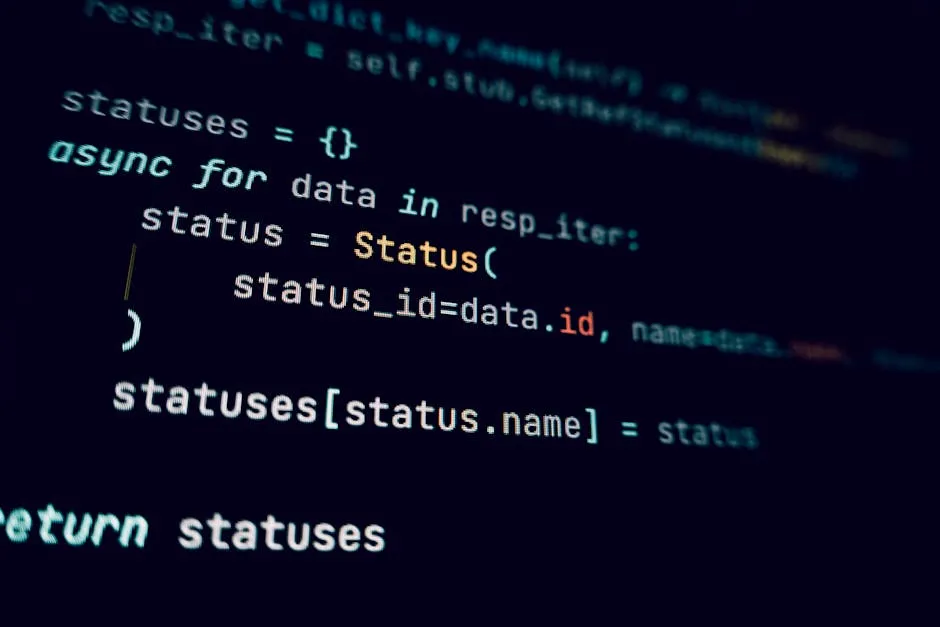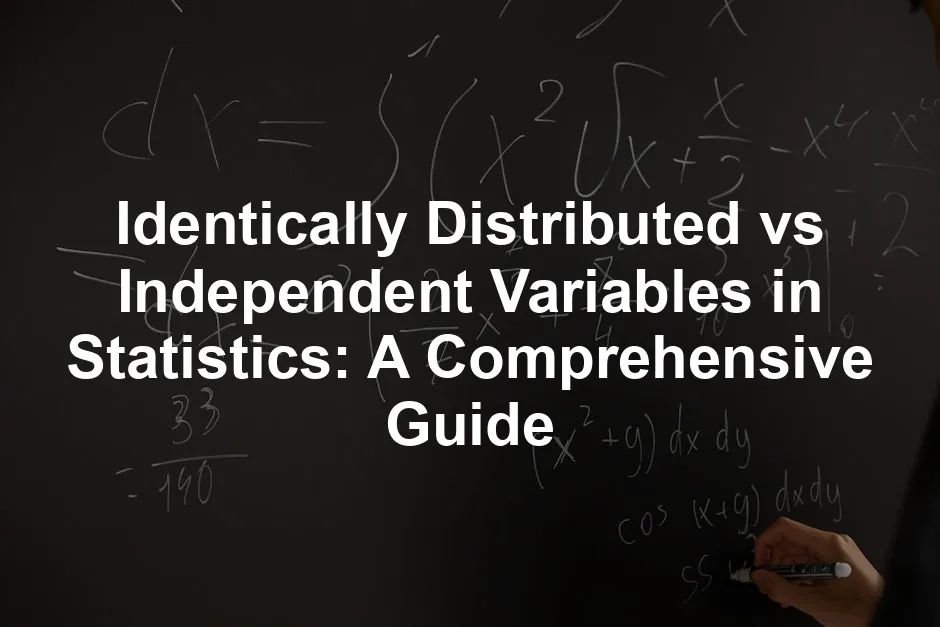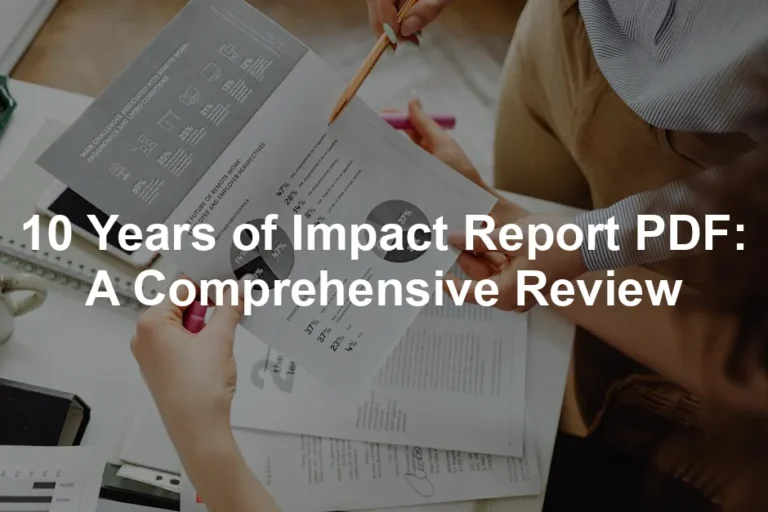Introduction
Statistics is like a secret language. It helps us understand the chaos around us. Random variables are the stars of this show. Grasping their nature is critical. When we say a variable is “independent,” it means its outcome doesn’t rely on others. An “identically distributed” variable, on the other hand, shares the same probability distribution with others.
Why does this matter? Well, in statistical analysis and machine learning, distinguishing between these concepts is vital. Imagine trying to predict the weather without knowing how different conditions interact. You’d be lost! This article will clarify these terms, helping you navigate through the statistical maze with ease.
By the end, you’ll learn the differences between independent and identically distributed variables. You’ll also grasp their significance in various applications, empowering you to make informed decisions in your statistical endeavors. So, buckle up! Let’s dive into the fascinating world of random variables.
If you’re looking to delve deeper into the world of statistics, consider picking up Random Variables: A Comprehensive Guide. It’s a fantastic resource that breaks down complex concepts in an engaging way!
Understanding Random Variables
What Are Random Variables?
Think of random variables as the quirky characters in a statistical drama. They represent outcomes of random processes. A random variable assigns a number to each outcome of a random event. For instance, flipping a coin can give us random variables like 0 for tails and 1 for heads.
Now, we can categorize random variables into two types: discrete and continuous. Discrete random variables have specific values. They often count things, like the number of heads in multiple coin flips. For example, if you flip a coin three times, the possible outcomes are 0, 1, 2, or 3 heads.
On the other hand, continuous random variables can take any value within a range. Picture measuring the height of people at a concert. Heights can vary infinitely, making them continuous random variables.

Types of Random Variables
Now, let’s shine a light on the different types of random variables. Independent random variables are like solo artists. Their outcomes do not affect each other. For example, if you toss a fair coin and roll a die, the result of one does not impact the other. They are free spirits!
Contrastingly, dependent random variables rely on one another. Think of siblings sharing a secret. Their outcomes are linked. If one sibling knows something, it can influence what the other knows.
Moving on to identically distributed random variables, these are like a group of identical twins. They share the same distribution but can be independent or dependent. For instance, if we measure the heights of individuals from the same population, they are identically distributed. However, if we draw samples from different populations, they may not share the same distribution, even if they are independent.
Understanding these distinctions lays the groundwork for grasping the more complex interactions between random variables. It’s crucial as we explore the concepts of independence and identical distribution further. Each type plays a role in shaping the statistical landscape, helping us analyze data effectively.
For a comprehensive understanding, grab a copy of Introduction to Probability. This book will equip you with the foundational knowledge you need!
Independent and Identically Distributed Variables (i.i.d.)
Definition of i.i.d.
Independent and identically distributed (i.i.d.) random variables are the golden duo in statistics. This term describes a collection of random variables that meet two essential criteria: they are independent and they share the same probability distribution.
Independence means that the outcome of one random variable doesn’t affect the outcome of another. Imagine flipping a coin. Each flip is a standalone event. The result of one flip—heads or tails—doesn’t sway the next one. This independence is crucial in statistical analysis. It ensures that our conclusions are not influenced by hidden relationships between variables.
Identically distributed means that all random variables in the collection come from the same probability distribution. This doesn’t imply that they have to be uniformly distributed; it simply means they share the same statistical properties. For instance, consider rolling a fair die multiple times. Each roll has the same probability distribution, giving a one-sixth chance for each outcome.
Understanding i.i.d. is vital because it forms the backbone of many statistical theories and methods. Without this assumption, analyses can become convoluted, leading to erroneous conclusions.
Looking to explore more on this topic? Check out Statistics for Data Science. It covers practical applications of these concepts in the data-driven world!

Characteristics of i.i.d. Variables
Independence
Independence in random variables is a straightforward concept. It simply means that knowing the result of one variable gives no insight into another. For example, take two coin flips. The outcome of the first flip doesn’t alter the odds or outcomes of the second flip. Whether you get heads or tails on the first flip, the second flip remains a 50/50 chance.
This characteristic is critical in statistical testing. Many tests, like the t-test, assume independence among observations. If this assumption is violated, the results can be misleading, much like a magician revealing how a trick works—it ruins the illusion!
Identical Distribution
Identically distributed random variables share the same probability distribution. To illustrate, think of a bag filled with red and blue balls. If you draw a ball from the bag, note its color, and then place it back before drawing again, each draw is identical in terms of distribution. The probabilities remain constant, regardless of previous draws.
Now, consider a scenario where you draw without replacement. The distribution changes with every draw since the total number of balls decreases. This leads to a situation where the draws are no longer identically distributed.
It’s important to understand that identical distribution does not mean all outcomes must be equally likely. For instance, if we flip a biased coin that lands on heads 70% of the time, all flips still follow the same distribution, even though they’re not equally likely.

Theoretical Importance of i.i.d.
The i.i.d. assumption is fundamental in many statistical methods, especially regarding the Central Limit Theorem (CLT) and the Law of Large Numbers (LLN).
The Central Limit Theorem states that when you take a large enough sample from a population, the distribution of the sample mean will tend toward a normal distribution, regardless of the original population’s distribution, provided the samples are i.i.d. This is like magic for statisticians! It allows for the application of normal distribution techniques even when dealing with non-normally distributed populations.
Similarly, the Law of Large Numbers asserts that as you draw more samples, the sample average will converge to the population average. This is essential for ensuring that our estimates are reliable. If our samples are not i.i.d., we risk skewing results, leading to misleading conclusions.
In conclusion, i.i.d. variables are pivotal in statistics. They streamline many analyses, allowing statisticians to draw conclusions with confidence. Understanding these concepts can empower data-driven decisions across various fields, from machine learning to healthcare. So, the next time you toss a coin or draw a ball from a bag, remember: you’re engaging with the fundamental principles of statistics!
Differences Between Independent and Identically Distributed Variables
Independence vs. Identical Distribution
Understanding the difference between independence and identical distribution can be tricky, but it’s crucial for grasping statistical concepts. Let’s break it down.
Independence means the outcome of one random variable does not affect another. Imagine flipping a coin. The result of one flip—whether it’s heads or tails—doesn’t influence the next flip. Each flip stands alone, like a lone wolf in the wild.
On the other hand, identically distributed refers to a group of random variables that share the same probability distribution. This means that if you were to look at their statistical properties—like the mean or variance—they would all be the same. Picture a bag of identical marbles. Each marble represents a random variable, and all are drawn from the same distribution.
Now, here’s where it gets interesting. Two random variables can be independent but not identically distributed. For instance, consider flipping a fair coin and rolling a die. The coin flip (with a 50% chance for heads or tails) and the die roll (with a one-sixth chance for each number) are independent events. But they have different distributions. Conversely, two random variables can be identically distributed yet dependent. For example, if you draw two cards from a standard deck without replacement, the outcome of the second draw depends on the first, but both draws are from the same distribution.
Examples to Illustrate Differences
Let’s get practical with some examples to illustrate these concepts clearly.
Independent but Not Identically Distributed: Imagine flipping a biased coin where heads come up 70% of the time. If you flip this coin multiple times, each flip is independent. Knowing the outcome of one flip gives no information about the next. However, the distribution isn’t identical to that of a fair coin, which has a 50% chance for heads.
Now, consider the classic example of rolling two dice. The outcome of one die does not influence the other. Thus, they are independent. However, if one die is a standard six-sided die and the other is a ten-sided die, they are not identically distributed.
Identically Distributed but Not Independent: Picture drawing cards from a deck without replacement. When you draw a card, the outcome of the first draw affects the second. If you draw an Ace, the chance of drawing another Ace drops significantly. Yet, each draw is identically distributed, as both draws are from the same deck with the same composition.
Another example could be measuring the height of two siblings. If they are from the same family, we expect their heights to follow the same distribution (identically distributed). However, knowing one sibling’s height gives you a clue about the other’s height, making them dependent.

Misleading Assumptions
Misunderstanding independence and identical distribution can lead to significant errors in statistical analysis. A common misconception is that independence implies identical distribution. Just because two events are independent doesn’t mean they share the same statistical properties.
For instance, in finance, analysts might assume stock returns are independent based on historical data. However, if those returns come from different stocks with varied risk exposures, they may not be identically distributed.
Another pitfall occurs when students assume that identical distribution guarantees independence. This is not the case, as demonstrated by the card-drawing example. If you’re drawing cards without replacement, the draws are not independent even though they are identically distributed.
These misconceptions can lead to incorrect conclusions in hypothesis testing and predictive modeling, ultimately skewing results and decisions.
Grasping the nuances between independence and identical distribution empowers statisticians to choose the right models and techniques for their data analysis. Always question assumptions and validate the underlying principles before drawing conclusions.
To further explore statistical modeling, consider reading The Art of Statistics: Learning from Data. It provides practical insights into data interpretation!
Practical Applications of i.i.d.
Applications in Machine Learning
In the realm of machine learning, the assumption of independent and identically distributed (i.i.d.) variables is more than a technical nicety; it’s foundational! Models are trained on data that ideally represents the entire population they aim to predict. If the training data isn’t i.i.d., predictions can go awry faster than a cat chasing a laser pointer!
Take supervised learning, for instance. Algorithms like linear regression, decision trees, and neural networks thrive on the i.i.d. assumption. Why? Because they rely on the notion that each data point is drawn from the same distribution and does not influence the others. Without this assumption, the model might learn relationships that don’t exist in the real world.
For example, consider a decision tree algorithm. It splits the data into branches based on features. If the data points are not independent—say, if they’re collected from a biased sample—the tree might make decisions based on noise rather than signal, leading to overfitting. In contrast, when data is i.i.d., the model can generalize better, making it more robust and reliable.
Some popular algorithms that heavily depend on the i.i.d. assumption include:
- Naïve Bayes: This algorithm assumes that features are independent given the class label. When this assumption holds true, it performs remarkably well. However, if the features are correlated, the model’s accuracy can plummet like a lead balloon.
- K-Nearest Neighbors (KNN): This algorithm classifies data points based on their proximity to others. If the training data isn’t i.i.d., the nearest neighbors may not be representative of the overall distribution, skewing the results.
- Support Vector Machines (SVM): SVMs aim to find the optimal separating hyperplane between classes. If the training data isn’t i.i.d., the hyperplane can be misaligned, leading to poor classification.
In summary, i.i.d. variables are the trusted companions in the journey of machine learning. They ensure that our models are trained on data that reflects the true underlying patterns, enabling accurate and generalizable predictions.

Statistical Testing
Statistical tests are the bread and butter of data analysis. They help us make inferences about populations based on sample data. But did you know that many of these tests rely on the i.i.d. assumption? Yes, indeed! Tests like t-tests, ANOVA, and chi-squared tests assume that the data points are independent and identically distributed.
Let’s take the t-test as an example. This test compares the means of two groups to see if they are significantly different. If the observations within each group are dependent or drawn from different distributions, the test results can be misleading. It’s like trying to compare apples and oranges—no sensible conclusions can be drawn!
The same goes for ANOVA, which assesses differences among group means. If the groups are not i.i.d., the F-statistic calculated may not accurately represent the variability within and between groups. This can lead researchers to false conclusions, akin to finding a unicorn in a haystack!
So, what are the consequences of violating the i.i.d. assumption? For starters, it can inflate Type I and Type II errors. In simpler terms, you might conclude there’s a significant effect when there isn’t one (Type I) or miss an actual effect (Type II). This can have real-world implications, especially in fields like healthcare, where decisions based on faulty statistics can affect lives.
Thus, verifying the i.i.d. condition before conducting statistical tests is paramount. Tools like graphical methods, such as Q-Q plots or residual plots, can help check for independence and identical distribution in your data.
If you’re interested in learning more about statistical software, consider getting Statistical Software: SPSS Statistics Standard Subscription. It’s a powerful tool for conducting complex analyses!

Real-World Scenarios
Understanding i.i.d. is not just for academia; it’s crucial in various fields like finance, healthcare, and social sciences. Let’s explore how it plays out in these sectors!
In finance, stock prices are often assumed to be i.i.d. when modeling returns. Traders use this assumption to develop algorithms for predicting future prices. If stock returns are not i.i.d.—for example, influenced by market events or trader sentiments—models can lead traders astray, resulting in significant financial losses. Think of it as betting on a game where the rules keep changing!
In healthcare, clinical trials rely heavily on the i.i.d. assumption. When testing a new drug, researchers must ensure that the subjects are randomly selected and that their responses are independent. If one participant’s outcome can influence another’s—like family members sharing genetic traits—the results could skew the efficacy of the drug. No one wants to be the guinea pig in a flawed experiment!
In social sciences, surveys often assume that responses are i.i.d. This allows researchers to generalize findings to the larger population. If a survey gathers responses from people who know each other, the independence assumption is violated. This can lead to biased results, like trying to measure the temperature of a room by only asking the people standing next to the heater.
In conclusion, the i.i.d. assumption is integral across various fields. It underpins statistical methodologies, ensuring that analyses yield valid and reliable insights. Emphasizing this concept not only aids in better analysis but also enhances decision-making in real-world applications.
To further enhance your analytical skills, consider checking out The Elements of Statistical Learning. It’s a must-read for those looking to master predictive modeling!
Conclusion
In the intricate dance of statistics, understanding the difference between independent and identically distributed (i.i.d.) variables is crucial. We’ve traversed the landscape of random variables, where independence signifies that one outcome doesn’t sway another. Identically distributed variables, on the other hand, share the same statistical properties.
Why does this matter? Well, grasping these concepts is essential for anyone venturing into data science or statistical analysis. When you assume that your data points are i.i.d., you lay the groundwork for many statistical tests and machine learning algorithms. This assumption ensures that your results are reliable and reflect the true nature of your data.
We’ve also uncovered the practical implications of these concepts. In machine learning, for instance, i.i.d. data can make or break your model’s performance. Training on i.i.d. data helps algorithms generalize better, leading to more accurate predictions. Conversely, when data deviates from the i.i.d. assumption, it can lead to biased conclusions and flawed insights.
So, as you embark on your own analyses, remember the significance of distinguishing between independent and identically distributed variables. This knowledge isn’t just academic; it’s a powerful tool in your data analysis toolkit. Use it wisely, and your statistical journey will be much smoother.
For a deeper dive into practical applications, consider reading The Data Science Handbook. It offers insights into real-world problems and solutions!
FAQs
What is the difference between independent and identically distributed variables?
Independent and identically distributed variables, often abbreviated as i.i.d., refer to a collection of random variables that share two essential properties. First, they are independent, meaning the outcome of one does not influence the outcome of another. For example, flipping a coin multiple times yields outcomes that are independent of each other. Second, they are identically distributed, indicating that all variables come from the same probability distribution. This means they share the same statistical properties, like mean and variance, even if their individual outcomes differ.
Can non-i.i.d. data still be useful?
Absolutely! While i.i.d. data is the gold standard for many analyses, non-i.i.d. data can still provide valuable insights. For example, time-series data often exhibit trends or seasonality, which makes the assumption of independence invalid. However, methods like time series analysis or mixed models can effectively handle such data. By using appropriate statistical techniques, you can still extract meaningful patterns and make informed decisions.
How can I test if my data is i.i.d.?
Testing for i.i.d. involves examining both independence and identical distribution. For independence, consider using statistical tests like the Chi-squared test or the Ljung-Box test to detect correlations in your data. Visualizations, such as scatter plots or autocorrelation plots, can also help identify relationships. For identical distribution, graphical methods like Q-Q plots or histograms can reveal trends or deviations in your data. If you observe a consistent shape across all samples, they are likely identically distributed.
When should I be concerned about the i.i.d. assumption?
You should be cautious about the i.i.d. assumption in several scenarios. If you are working with time-dependent data, such as stock prices or weather patterns, independence may not hold due to autocorrelation. Similarly, when dealing with hierarchical data or clustered samples, the assumption can be violated. Understanding the data structure is paramount. If the i.i.d. condition doesn’t hold, it can lead to misleading results and incorrect conclusions.
Are there examples of real-world data that are not i.i.d.?
Definitely! In finance, stock returns often exhibit dependence due to market trends or external events. If one stock drops, others in the same sector may follow suit, violating the independence assumption. In social sciences, survey data collected from groups of friends or family members can also be non-i.i.d., as the responses may be correlated. Recognizing these examples helps in designing better studies and choosing the right analytical methods.
For a deeper understanding of the various statistical methods for finance professionals in 2024, it’s crucial to explore how these concepts apply in real-world scenarios.
If you’re looking for a fun way to engage with statistics, consider getting some Educational Board Games for Learning Statistics. They make learning both enjoyable and effective!
Please let us know what you think about our content by leaving a comment down below!
Thank you for reading till here 🙂
All images from Pexels




